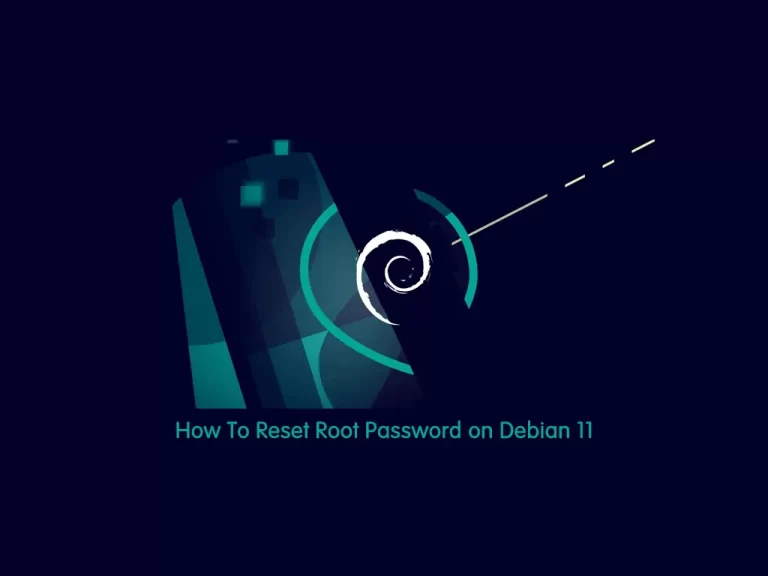Share your love
How To Install and Use Webmin on Debian 11

In this guide, we want to teach you How To Install and Use Webmin on Debian 11.
Webmin is a web-based interface for system administration for Linux/Unix. Webmin also allows for controlling many machines through a single interface or seamless login on other Webmin hosts on the same subnet or LAN. You would use any modern web browser to connect to your server. Webmin removes the need to edit Linux/Unix configuration files manually, and it lets you manage a server from the console or remotely.
With Webmin, you can configure operating system internals such as users, service or configuration files, and disk quotas, as well as modify and control open source applications such as Apache or Tomcat, PHP, MySQL, DNS, and file sharing. Webmin, based on Perl, runs as its own process and a web server.
Install and Use Webmin on Debian 11
To install Webmin, you must log in to your server as a non-root user with sudo privileges and set up a basic firewall. To do this, you can follow our guide the Initial Server Setup with Debian 11.
Now follow the steps below to complete this guide.
Installing Webmin on Debian 11
First, you need to update your local package index with the command below:
sudo apt update Then, install the required packages by running the following command:
sudo apt install gnupg2 curl -y
By default, Webmin packages aren’t available in the default Debian repository. So you must add the Webmin repository to your server.
To do this, download and add the Webmin GPG key with the following command:
wget -qO - http://www.webmin.com/jcameron-key.asc | sudo apt-key add -
Next, use the command below to add the Webmin repository:
sudo sh -c 'echo "deb http://download.webmin.com/download/repository sarge contrib" > \ /etc/apt/sources.list.d/webmin.list'
When you are finished, update your local package index:
sudo apt updateAt this point, you can use the following command to install Webmin:
sudo apt install webminWhen your installation is completed, let’s see how to start and enable your service.
How To Manage Webmin Service
You can start your Webmin service on Debian 11 by running the command below:
sudo systemctl start webmin
To enable your service to start on boot, run the command below:
sudo systemctl enable webminVerify your service is active and running on your server:
sudo systemctl status webmin
In your output you will see:
Output
● webmin.service - Webmin server daemon
Loaded: loaded (/lib/systemd/system/webmin.service; enabled; vendor preset>
Active: active (running) since Wed 2022-08-17 02:53:52 EDT; 3min 12s ago
Main PID: 3300 (miniserv.pl)
Tasks: 1 (limit: 2340)
Memory: 26.4M
CPU: 802ms
CGroup: /system.slice/webmin.service
└─3300 /usr/bin/perl /usr/share/webmin/miniserv.pl /etc/webmin/minConfigure UFW Firewall for Webmin
At this point, we assumed that you have enabled UFW firewall from the requirements.
By default, Webmin listens on port 100000. You can check it using the following command:
ss -antpl | grep 10000
You should see the following output:
Output
LISTEN 0 4096 0.0.0.0:10000 0.0.0.0:* users:(("miniserv.pl",pid=4073,fd=5))
Now you need to allow Webmin port 10000 through the Debian firewall with the following command:
sudo ufw allow 10000
Reload the firewall to apply the new rules:
sudo ufw reloadAccess Webmin Dashboard
At this step, you can access your Webmin dashboard on Debian 11 through the web interface by typing your server’s IP address in your web browser followed by 10000:
https://server-ip:10000You will see your Webmin login screen:

Provide your root username, and password, and click on the Sign in button. You should see the Webmin dashboard:

Now from your Webmin dashboard, you can perform your tasks.
How To Use Webmin
From your dashboard, in the left pane, click on the Tools => Command Shell. You can access your Linux terminal and execute your commands.

You can easily create a file or directory and manage the entire file system. To do this, Click on the Tools => File Manager.

To upload and download any file to your Debian 11 server, Click on the Tools => Upload and Download from your Webmin dashbaord.

Click on the Networking => Network Configuration. You should see the network configuration wizard.
From here, you can set up a static IP address, default gateway, hostname, and DNS.

Click on the Hardware => Partitions and Local Disks.
From here, you can create and edit your hard disk partitions.
Remove Webmin from Debian 11
If you no longer want to use Webmin, you can remove it by running the command below:
sudo apt remove webminNext, run the following command to clean the package cache and remove unwanted packages from your system.
sudo apt autoremove -y sudo apt clean
Conclusion
At this point, you learn to Install and Use Webmin on Debian 11.
Hope you enjoy using it.
You may be interested in these articles:
How To Set up aaPanel on Debian 11
Set up Nessus Scanner on Debian 11



